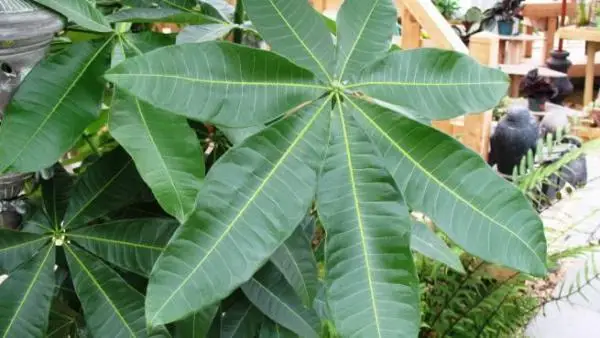The genus Pachira belongs to the family of the Bombáceas and is formed by more than 80 species that have their origin in the tropical regions of Central and South America. One of the best known species is the aquatic pachira, also known as the water ceibo, the water sapote, the guinea chestnut or the guinea-fowl chestnut. It is an elegant tree that can grow up to 20 meters tall if they are in their natural habitat.
Its leaves are large, shiny, lanceolate, and palmate, and its flowers are a lovely purple-pink color that is perfectly complemented by its long red stamens. The flowers last a few days, although the truth is that they bloom several times throughout the year. More than as a tree, it is used as an indoor plant since outside the tropics it does not support low temperatures. Keep reading this article if you want to know everything about the cultivation and care of aquatic pachira.
Information about La Pachira
In our country, however, the pachira is marketed as a very elegant indoor specimen with a rustic appearance characterized by its large Amazonian leaves and its curious trunk rolled up like a braid.
This tropical plant has been introduced indoors relatively recently, so it is still difficult to know exactly the best ways to maintain it.
The fact that this plant lives in water or very close to aquatic places is a factor that leads to the confusion of many people: Most of us would think that for this reason it will need to be constantly watered, but in fact an excessive watering will very possibly flood its roots and will end it.
If the leaves of your pachira turn pale or any of its trunks become soft, you should remove the dead parts and stop watering for a week to maintain the health of the plant.
Finally, to keep its beautiful leaves clean and shiny, you should spray water on them at a distance of about 40 centimeters. The best time to do it is after sunset watering.

Cultivation and care
The basic care of this plant are:
- Temperature : it does not have many demands in this regard, the only one is that it cannot be at temperatures below 12ºC. It is also not recommended that you put it near a heater.
- Lighting : you need to be in a well-lit place but without receiving direct sunlight.
- Humidity : there must be an environmental humidity that does not drop below 60%, so it is advisable to spray the plant frequently in order to keep it at optimal levels.
- Soil : it is not a very demanding plant with the soil, and as long as it has good drainage, it adapts to any type.
- Watering : it doesn’t need a lot of water, so always wait until the soil is dry before watering again. If the temperatures are lower than 18ºC you will have to water less.
- Pruning : it is done when the cold ends to control its growth and give it shape for the arrival of good weather, which brings more leaves and flowers.
- Fertilizer : apply a mineral fertilizer monthly, only during spring and summer.
- Multiplication : the best option is the one made by cuttings from a branch with healthy leaves.

